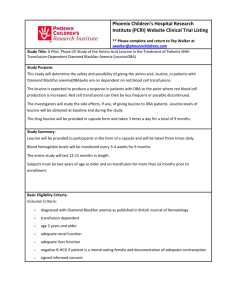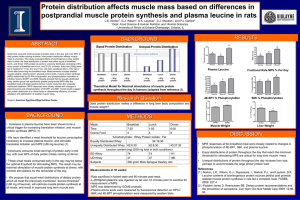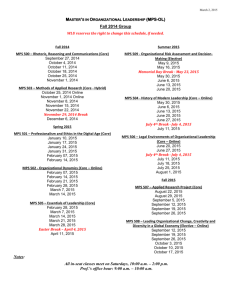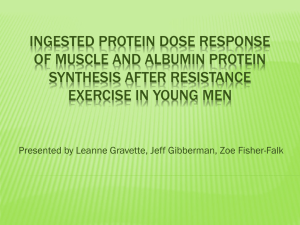Optimal protein intake to maximize muscle protein synthesis
advertisement
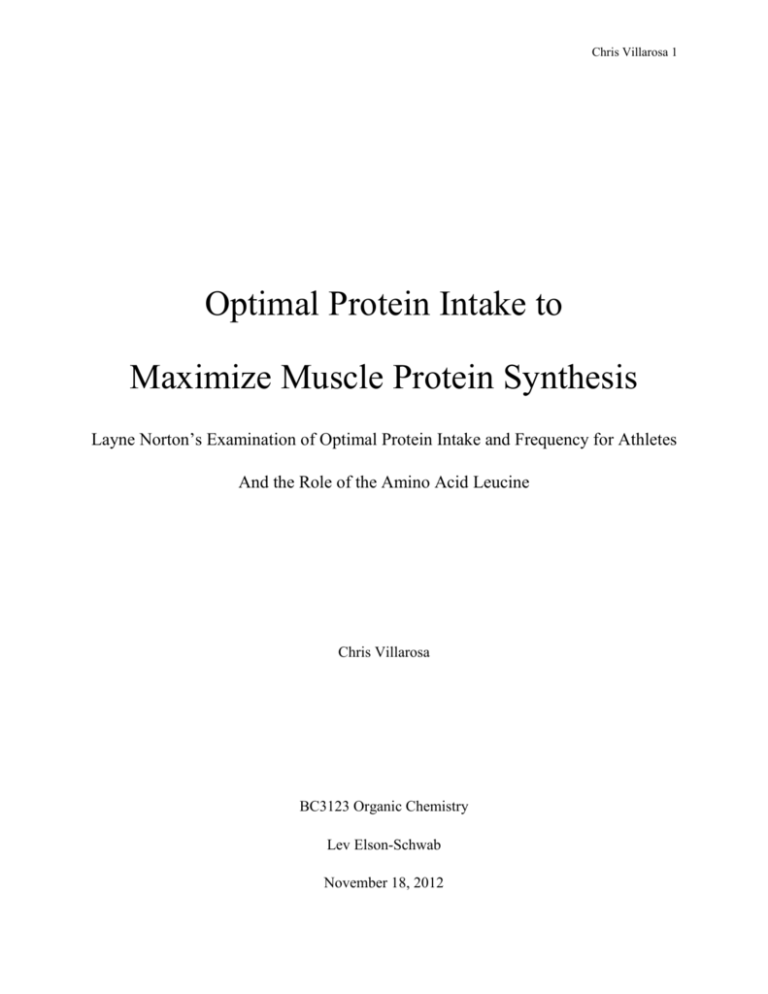
Chris Villarosa 1 Optimal Protein Intake to Maximize Muscle Protein Synthesis Layne Norton’s Examination of Optimal Protein Intake and Frequency for Athletes And the Role of the Amino Acid Leucine Chris Villarosa BC3123 Organic Chemistry Lev Elson-Schwab November 18, 2012 Chris Villarosa 2 Layne Norton is a renowned competitive powerlifter and natural bodybuilder as well as highly respected coach. Among his enthusiasm for athleticism and competitiveness, Layne also displays a passion for science having obtained a BS in Biochemistry and a PhD in Nutritional Sciences (1). Fueled by his unique interests in the field of exercise and science, Layne’s thesis emphasis was on muscle protein metabolism, and more specifically, the synthesis of skeletal muscle and the role of leucine as an initiating determinant factor. His research concluded that the meal content of the amino acid leucine is largely responsible for the anabolic effects of muscle protein synthesis (MPS). In his examination of optimal protein intake and frequency, Layne suggests that the MPS reponse to plasma leucine levels may remain elevated for as long as three hours, but will decline despite nutritional or supplement interventions (2). The intent of this paper is to present Layne Norton’s findings and interpretations of his research relevant to MPS. Layne Norton’s discovery regarding the importance of the amino acid leucine and its effects on MPS are essential in the sport nutrition world for its applications of macronutrient recommendations and amino acid profile in an athlete’s diet. Although the recommended daily allowance (RDA) suggests that dietary protein intake only be met for metabolic requirements, the 0.8g/kg of protein that is necessary to maintain short-term nitrogen balance may not be applicable for all individuals (3). Layne attributes this statement by refuting the general consensus that “meeting the minimum requirements for the most limiting amino acids in protein will lead to a plateau of nitrogen retention and any further increase in plasma amino acids would stimulate increased oxidation and elimination of excess amino acids.” Under this assumption, any additional dietery intake of amino acids would be irrelevant; the common misconception. Layne’s research begs to differ. His discovery suggests that although excessive amino acid oxidation may take place, these amino acids may additionally initiate signaling necessary for MPS. Layne concluded that the initiation of the MPS pathway is largely due to plasma leucine levels and that RDA for protein intake is insufficient for an athlete whose goals are to maintain or gain lean muscle tissue (2). Denouncing overall gram-per-day protein intake, Layne suggests that the distribution of protein throughout the day is highly relevant to MPS. His research suggests a large correlation between the protein content of a meal, specifically the leucine concentration of the protein within that meal, and its relationship to anabolic protein synthesis. As his research shows, leucine has Chris Villarosa 3 been proposed to account for the facilitation of signaling MPS. In Layne’s lab, an isocaloric isonitrogenous diet manipulated by whey protein or wheat gluten demonstrated a difference in post-prandial plasma leucine content and variations of MPS stimulation suggesting that amino acid profile largely plays a role in determining an anabolic protein-synthesizing signal. This specific MPS signal is proposed to be the mammalian target of rapamaycin (mTOR) signaling pathway (2, 4). Layne’s work suggests that mTOR stimulation via leucine initiates translation by increasing the rate of eukaryotic initiation factor 4F complex (eIF4F) which 43S preintiation complex must need present in order to bind to mRNA. This rate-limiting step is facilitated by increased leucine-induced phosphorylation of an inhibitory protein, eukaryotic initiation factor 4E binding protein 1 (4E-BP1). 4E-BP1 binds to eukaryotic initiation factor 4E (eI4FE) and inhibits the formation of a complex produced by the association of eI4FE and eukaryotic initiation factor 4G (eIF4G). The product of 4E-BP1 phosphorylation results in the ability of eIF4F and eIF4G to form the eIF4F complex. Additionally, Layne found that mTOR activation via leucine also assists in the phosphorylation of p70 S6 kinase (S6K), a ribosomal protein that increases selective mRNA translation specific to the mechanism of MPS which also dictates overall MPS capacity of a cell. These findings demonstrate the importance of leucine and MPS. After examining the effects of leucine and MPS, Layne determines optimal values of leucine content in a meal as well as meal frequency to maximize the MPS response. Based on the research of others, Layne concludes that 3g of leucine is sufficient for a MPS reponse. Layne and his team then demonstrate the effects of a complete meal on MPS. After an analysis of plasma and intramuscular leucine concentrations after a meal, Layne concludes that although a purified amino acid solution containing exclusively leucine or a combination of leucine and other essential amino acids may heighten the anabolic MPS response for 2 hours, a complete meal containing similar leucine values may prolong the anabolic response for up to 3 hours despite a reduction in leucine concentrations after a peak between 45-180 minutes. Despite a reduction following its peak, leucine concentrations remained above baseline for five hours while MPS returned to baseline values after the 3-hours leucine concentration peak. Layne also concludes that despite dietary interventions that increase plasma leucine levels, mTOR signaling and MPS duration was not increased in efforts to sustain MPS. Based on this phenomenon, Layne suggests Chris Villarosa 4 a refractory period that follows peaked MPS (2); a mechanism in which Layne can only currently make proposals to, but not make definite conclusions about. In conclusion, Layne’s research demonstrates the importance of the branch-chain amino acid, leucine and its role in contributing to MPS. In summary, Layne’s contribution to science and discoveries suggest: protein intake is strongly correlated to leucine density in a given meal, dietary leucine and increased plasma leucine levels increase mRNA translation permissive for MPS, optimal leucine levels are about 3g per meal, and any additional supplemental or dietary interventions to increase MPS duration are irrelevant in between four to six hour intervals post prandially. Without a doubt, knowledgeable athletes and dieticians can utilize Layne’s research, results, and discoveries to enhance performance or body composition goals for themselves or their clients. Collectively, Layne’s research provides a solid irrefutable foundation for optimal protein utilization in the diet. Where the generic “calories in vs. calories out” mentality may resound, this research simply denounces any false perception that all calories are created equal. Furthermore, the RDA of 0.8g/kg protein proves its irrelevance through Layne’s research in a population that desires lean mass gains or muscular performance enhancement. Chris Villarosa 5 References 1. About biolayne. (2011). Retrieved from http://www.biolayne.com/about/ 2. Norton, L. E. (2009). Optimal protein intake to maximize muscle protein synthesis. Argo food industry hi-tech, 20(2), 54-57. Retrieved from http://www.biolayne.com/wpcontent/uploads/Norton-J-Ag-Food-Ind-Hi-Tech-2008.pdf 3. Campbell, B. (2007). International society of sports nutrition position stand: protein and exercise. 4(8), Retrieved from http://www.jissn.com/content/pdf/1550-2783-4-8.pdf 4. Norton, L. E. (2006 ). Leucine regulates translation initiation of protein synthesis in skeletal muscle after exercise. The journal of nutrition, 136(2), 533S-537S. Retrieved from http://jn.nutrition.org/content/136/2/533S.long
